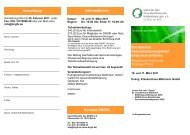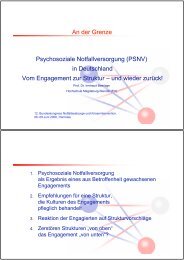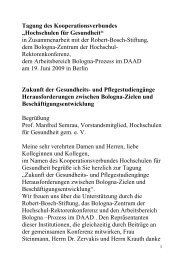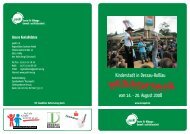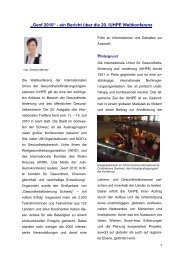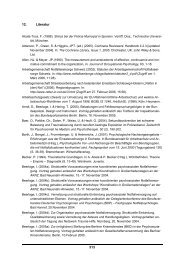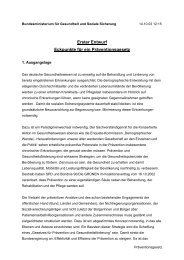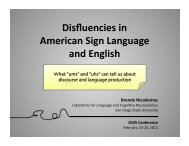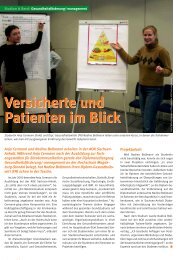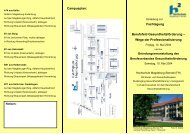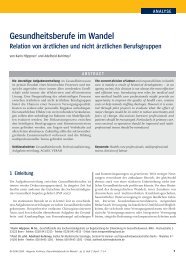Constructed Action in an Unfamiliar Sign Language Register
Constructed Action in an Unfamiliar Sign Language Register
Constructed Action in an Unfamiliar Sign Language Register
You also want an ePaper? Increase the reach of your titles
YUMPU automatically turns print PDFs into web optimized ePapers that Google loves.
<strong>Constructed</strong> <strong>Action</strong><br />
<strong>in</strong> <strong>an</strong><br />
<strong>Unfamiliar</strong> <strong>Sign</strong> L<strong>an</strong>guage <strong>Register</strong><br />
Silke Matthes<br />
University of Hamburg<br />
silke.matthes@sign-l<strong>an</strong>g.uni-hamburg.de
Introduction<br />
“<strong>Unfamiliar</strong> <strong>Sign</strong> L<strong>an</strong>guage <strong>Register</strong>?”<br />
Academic context: MSc dissertations (CDS, Bristol)<br />
Overview:<br />
• Sociocultural context<br />
• Conditions of l<strong>an</strong>guage production<br />
• L<strong>an</strong>guage device: <strong>Constructed</strong> <strong>Action</strong> (CA)<br />
• Examples of CA <strong>in</strong> a MSc Dissertation
Sociocultural Context: Orality & Literacy<br />
Literacy: Societal life is determ<strong>in</strong>ed by the use of writ<strong>in</strong>g<br />
Orality:<br />
Cultures without <strong>an</strong>y writ<strong>in</strong>g system<br />
The (non-) existence of writ<strong>in</strong>g affects cognitive processes as well as<br />
the modes of expression used.<br />
Oral cultures:<br />
• Knowledge is tied to the person<br />
• Communication is restricted to face-to-face contact<br />
• Different techniques for pass<strong>in</strong>g on knowledge are used<br />
• ...<br />
(Günther/Ludwig 1994; Ong 1985)
<strong>Sign</strong> L<strong>an</strong>guage Communities<br />
• No generally accepted writ<strong>in</strong>g system<br />
• Characteristics typical for oral cultures (e.g. H<strong>an</strong>sen 2005)<br />
• Cultural m<strong>in</strong>ority <strong>in</strong> a strongly literal (hear<strong>in</strong>g) majority society<br />
• Mak<strong>in</strong>g use of the majority’s writ<strong>in</strong>g system<br />
• Frequently switch<strong>in</strong>g between the two l<strong>an</strong>guages<br />
(mostly predeterm<strong>in</strong>ed)
<strong>Sign</strong> L<strong>an</strong>guages & Academia<br />
• Increas<strong>in</strong>g possibilities for Deaf students to enter universities<br />
• <strong>Sign</strong> l<strong>an</strong>guage is more commonly used<br />
But yet...<br />
• Strongly literal context:<br />
Major <strong>in</strong>fluence of written l<strong>an</strong>guage c<strong>an</strong> be expected<br />
• Written l<strong>an</strong>guage is predom<strong>in</strong><strong>an</strong>t (receptive <strong>an</strong>d productive)<br />
• Limited possibilities to develop <strong>an</strong> adequate register
Conditions of L<strong>an</strong>guage Production:<br />
Medium & Conception of Discourse<br />
Medium<br />
Conception<br />
oral<br />
literate<br />
spoken<br />
private<br />
conversation<br />
religious<br />
sermon<br />
written<br />
newspaper<br />
<strong>in</strong>terview<br />
scientific<br />
article<br />
(Koch/Oesterreicher 1990; Oesterreicher 1997)
Conception: Communicative Conditions<br />
Oral:<br />
private sett<strong>in</strong>g<br />
familiarity & emotional <strong>in</strong>volvement<br />
contextually embedded<br />
face-to-face situation<br />
dialogue<br />
spont<strong>an</strong>eous<br />
Communicative<br />
immediacy<br />
Literate:<br />
public sett<strong>in</strong>g<br />
formality & emotional detachment<br />
contextually dissociated<br />
physically dist<strong>an</strong>t<br />
monologue<br />
reflected<br />
Communicative<br />
dist<strong>an</strong>ce<br />
(Koch/Oesterreicher 1990; Oesterreicher 1997)
Academic Context: L<strong>an</strong>guage of Dist<strong>an</strong>ce<br />
Different conditions result <strong>in</strong> different communicative strategies.<br />
Dist<strong>an</strong>ce communication is marked by:<br />
• High degree of discourse pl<strong>an</strong>n<strong>in</strong>g<br />
• High <strong>in</strong>formation density<br />
• High <strong>in</strong>tegration <strong>an</strong>d complexity of l<strong>in</strong>guistic units<br />
L<strong>in</strong>guistic devices to be used for various strategies are required<br />
on all levels (lexical-sem<strong>an</strong>tic, syntactic, textual, <strong>an</strong>d pragmatic).<br />
(Koch/Oesterreicher 1990)
Immediacy & Dist<strong>an</strong>ce <strong>in</strong> <strong>Sign</strong> L<strong>an</strong>guages<br />
Medium<br />
Conception<br />
immediate<br />
dist<strong>an</strong>t<br />
“spoken”<br />
?<br />
written<br />
? ?
MSc Dissertations<br />
Inform<strong>an</strong>ts’ view (<strong>in</strong>terviews):<br />
Film<strong>in</strong>g<br />
• Cont<strong>in</strong>uous sign<strong>in</strong>g needed<br />
• Repetition required due to mistakes<br />
• Pl<strong>an</strong>n<strong>in</strong>g <strong>an</strong>d notes <strong>in</strong> English<br />
MSc Dissertation, CDS (Bristol)<br />
L<strong>an</strong>guage<br />
• “English” structure<br />
• <strong>Register</strong> “unnatural” for SL<br />
• Not “my BSL”<br />
MSc Dissertation, CDS (Bristol)
<strong>Constructed</strong> <strong>Action</strong> (CA)<br />
• The signer uses his/her own body to depict <strong>an</strong> event or action<br />
of <strong>an</strong> entity: The signer 'becomes' the referent.<br />
• One-to-one correspondence between (parts of) the body <strong>an</strong>d<br />
the <strong>in</strong>tended referent<br />
• Alternation between different discourse elements<br />
(often rapidly switch<strong>in</strong>g)<br />
• Pure CA or parallelisation of CA with lexemes or classifier<br />
constructions (Fischer 2006).<br />
• Markers: eye gaze, body shift, facial expressions, ...
CA <strong>in</strong> Different <strong>Register</strong>s<br />
• Ma<strong>in</strong>ly perceived as <strong>an</strong> element of narrative discourse:<br />
High potential to enact events <strong>an</strong>d emotions<br />
• CA <strong>in</strong> <strong>an</strong> ASL lecture:<br />
Involve the audience, make it <strong>in</strong>terest<strong>in</strong>g (Roy 1989, W<strong>in</strong>ston 1992)<br />
• Independent of register<br />
CA <strong>in</strong> formal as well as non-formal registers (Qu<strong>in</strong>to-Pozos et al. 2006)<br />
CA <strong>in</strong> expl<strong>an</strong>ations of me<strong>an</strong><strong>in</strong>g (def<strong>in</strong>itions) (Fischer/Kollien 2010)
CA as a Functional Discourse Element<br />
• <strong>Sign</strong>ed modality allows for simult<strong>an</strong>eous convey<strong>an</strong>ce of<br />
complementary <strong>in</strong>formation<br />
• Very precise characteristics of a referent c<strong>an</strong> be expressed<br />
• Facilitates comprehension <strong>an</strong>d recognition for recipients<br />
Assumptions:<br />
• Functional, possibly obligatory, element of all signed discourse<br />
• C<strong>an</strong> be expected to occur across all registers<br />
• Differences <strong>in</strong> realisation depend<strong>in</strong>g on registers<br />
(Fischer/Kollien 2006, Qu<strong>in</strong>to-Pozos 2007)
CA <strong>in</strong> a MSc Dissertation<br />
MSc Dissertation:<br />
• 13m<strong>in</strong> <strong>an</strong>alysed (total 2h 17m<strong>in</strong>)<br />
• 94 occurrences of CA<br />
CA+Lex.<br />
CA<br />
CD<br />
CA+CL<br />
Private Conversation:<br />
• Same <strong>in</strong>form<strong>an</strong>t <strong>in</strong> a private sett<strong>in</strong>g<br />
• Topic: Investigation <strong>in</strong> family history<br />
• 3m<strong>in</strong> <strong>an</strong>alysed (total 11m<strong>in</strong>)<br />
• 50 occurrences of CA<br />
CA+Lex.<br />
CA+CL<br />
CD<br />
CA
Example from MSc Dissertation:<br />
• Markers: eye gaze, body movement, facial expressions<br />
• Short duration of depiction<br />
• CA + lexical sign<br />
• here: no mouth<strong>in</strong>g<br />
referentiellen Verortung im Gebärdenraum und unterscheidet sich dam<br />
Blickverhalten während e<strong>in</strong>er CA. Die unterschiedliche Funktion des B<br />
haltens wird im folgenden Beispiel deutlich:<br />
Beispiel 1 (MSc-Arbeit):<br />
Glosse: CHILDREN LEARN WHAT ENGLISH<br />
CA:<br />
M18: expect<strong>an</strong>t, happy<br />
Blick: unten oben rechts (Kamera) (Kamera)<br />
CHILDREN<br />
CHILDREN<br />
CA<br />
M18<br />
/ LEARN<br />
CA / LEARN<br />
Während der Gebärde CHILDREN ist der Blick nach unten gerichtet u
Example from Private Conversation:<br />
wie sie das Dokument <strong>in</strong> ihren Händen zunächst betrachtet und plötz<br />
entdeckt. E<strong>in</strong> solches „Halten“ der CA ist <strong>in</strong> der MSc-Arbeit nicht zu f<br />
• Markers: eye gaze, facial expressions<br />
• More emphatic depiction<br />
Beispiel 4 (Privatgespräch):<br />
• Pure CA<br />
CA<br />
P34: (look at paper) be struck/ amazed<br />
P34 CA 67<br />
CA: look at paper
Parallelisation<br />
M24a CA / WAIT++<br />
CA / WAIT<br />
M24b CA / CL<br />
CA / CL<br />
wird hier die Mutter, die mit ihrem K<strong>in</strong>d kommuniziert. In M24 wird<br />
• Mostly short duration of depiction<br />
llelisierter CA gezeigt, wie sie erwartungsvoll abwartet, bis e<strong>in</strong> Blickdem<br />
K<strong>in</strong>d entst<strong>an</strong>den ist. Diese CA über die beiden m<strong>an</strong>uellen<br />
• CA + lexical sign or CL<br />
en WAIT++ (mit wiederholter Ausführung des Lexems zur Anzeige<br />
• Mouth<strong>in</strong>g<br />
dauerns) und CL:eye contact h<strong>in</strong>weg wird markiert durch e<strong>in</strong>en<br />
CA / SPEAK (babble)
Beispiel 7 (MSc-Arbeit) 68 :<br />
Pure CA<br />
WHEN OBSERVE+ SIGN+ [CA] SOM<br />
M34: observe adult sign<strong>in</strong>g M35: reflect on own sign<strong>in</strong>g<br />
• H<strong>an</strong>ds are part of the construction<br />
[CA] NEVER USE OFF++<br />
M36: realise some h<strong>an</strong>dshape don’t fit<br />
• (Sequence: different referents are present <strong>in</strong> discourse)<br />
M34a CA / OBSERVE+ M34b CA / SIGN+ M35 CA SO<br />
CA / OBSERVE / SIGN<br />
(child + adult)<br />
CA: look at h<strong>an</strong>ds<br />
(child)
Occurrences of CA<br />
MSc dissertation:<br />
• No strongly emphatic depiction<br />
• Subtle presence of CA <strong>in</strong> the discourse<br />
• Mostly parallelised, present<strong>in</strong>g additional <strong>in</strong>formation<br />
Private conversation:<br />
• Little emphatic depiction<br />
• More dist<strong>in</strong>ct presence <strong>in</strong> the discourse<br />
• Higher amount of CA without parallisation
Possible Functions of CA<br />
• Referents are made present <strong>in</strong> the discourse<br />
(e.g. not lexically specified / additional entities)<br />
• High <strong>in</strong>formation density:<br />
additional <strong>in</strong>formation is conveyed simult<strong>an</strong>eously<br />
• Efficient convey<strong>an</strong>ce of me<strong>an</strong><strong>in</strong>gs that c<strong>an</strong> not easily be<br />
expressed lexically
Conclusion<br />
• “Oral” m<strong>in</strong>ority <strong>in</strong> a strongly literal society<br />
• Academia: Conceptual shift to a l<strong>an</strong>guage use of high dist<strong>an</strong>ce<br />
• CA as a l<strong>an</strong>guage device used <strong>in</strong> this formal sett<strong>in</strong>g<br />
• Written English used for pl<strong>an</strong>n<strong>in</strong>g<br />
• <strong>Unfamiliar</strong>, underdeveloped register<br />
Technical realisation:<br />
Development of tools for SL,<br />
e.g. Dicta-<strong>Sign</strong> project<br />
Edit<br />
(www.dictasign.eu)
References<br />
Fischer, Renate /Kollien, Simon (2006). <strong>Constructed</strong> action <strong>in</strong> DGS: Roses Aktions=Fragmente (Teil I). Das Zeichen 72, pp. 96-106.<br />
Fischer, Renate /Kollien, Simon (2010). Gibt es <strong>Constructed</strong> <strong>Action</strong> <strong>in</strong> Deutscher Gebärdensprache und <strong>in</strong> Deutsch (<strong>in</strong> der Textsorte<br />
Bedeutungserklärung)? Das Zeichen 86, pp.502-510.<br />
Günther, Hartmut /Ludwig, Otto (Eds.) (1994). Schrift und Schriftlichkeit: e<strong>in</strong> <strong>in</strong>terdiszip<strong>in</strong>äres H<strong>an</strong>dbuch <strong>in</strong>ternationaler Forschung.<br />
H<strong>an</strong>dbücher zur Sprach- und Kommunikationswissenschaft, Vol. 10.1. Berl<strong>in</strong>: De Gruyter.<br />
H<strong>an</strong>sen, Martje (2005). Verfahren der Markierung sem<strong>an</strong>tischer Rollen am Erstakt<strong>an</strong>ten <strong>in</strong> der Deutschen Gebärdensprache. Doctoral diss.,<br />
University of Hamburg.<br />
Koch, Peter / Oesterreicher, Wulf (1990). Gesprochene Sprache <strong>in</strong> der Rom<strong>an</strong>ia: Fr<strong>an</strong>zösisch, Italienisch, Sp<strong>an</strong>isch. Tüb<strong>in</strong>gen: Max Niemeyer.<br />
Liddell, Scott (2003). Grammar, gesture, <strong>an</strong>d me<strong>an</strong><strong>in</strong>g <strong>in</strong> Americ<strong>an</strong> <strong>Sign</strong> L<strong>an</strong>guage. Cambridge: Cambridge University Press.<br />
Metzger, Mel<strong>an</strong>ie (1995). <strong>Constructed</strong> action <strong>an</strong>d constructed dialogue <strong>in</strong> Americ<strong>an</strong> <strong>Sign</strong> L<strong>an</strong>guage. In Lucas, Ceil (Ed.): Sociol<strong>in</strong>guistics <strong>in</strong><br />
Deaf communities, pp. 255-271. Wash<strong>in</strong>gton D.C.: Gallaudet University Press.<br />
Oesterreicher, Wulf (1997). Types of Orality <strong>in</strong> Text. In Bakker, Egbert / Kah<strong>an</strong>e, Ahuvia (Eds.): Written Voices, Spoken <strong>Sign</strong>s, pp.190-214.<br />
Cambridge, Massachusetts: Harvard University Press.<br />
Ong, Walter J. (1985). Orality <strong>an</strong>d Literacy. The Technologiz<strong>in</strong>g of the Word. New York: Methuen & Co.<br />
Qu<strong>in</strong>to-Pozos, David / Mehta, Sarika / Reynolds, W<strong>an</strong>ette (2006): The effects of register on the production of <strong>an</strong> ASL text. Conference<br />
poster. Theoretical Issues <strong>in</strong> <strong>Sign</strong> L<strong>an</strong>gage Research 9. Flori<strong>an</strong>ópolis, Brasil.<br />
Qu<strong>in</strong>to-Pozos, David (2007). Why Does <strong>Constructed</strong> <strong>Action</strong> Seem Obligatory? An Analysis of “Classifiers” <strong>an</strong>d the Lack of<br />
Articulator-Referent Correspondence. <strong>Sign</strong> L<strong>an</strong>guage Studies 7(4), pp. 458-506.<br />
Roy, Cynthia. B. (1989). Features of Discourse <strong>in</strong> <strong>an</strong> Americ<strong>an</strong> <strong>Sign</strong> L<strong>an</strong>guage Lecture. In Lucas, Ceil (Ed.): The Sociol<strong>in</strong>guistics of the Deaf<br />
Community, pp. 231-251. S<strong>an</strong> Diego, California: Academic Press.
Acknowledgements<br />
CDS (Bristol), esp. Deaf <strong>in</strong>form<strong>an</strong>ts <strong>an</strong>d <strong>in</strong>terpreters<br />
My supervisors Prof. Renate Fischer & Simon Kollien<br />
The workshop org<strong>an</strong>isers <strong>an</strong>d <strong>in</strong>terpreters<br />
Th<strong>an</strong>k you for your attention<br />
Contact<br />
silke.matthes@sign-l<strong>an</strong>g.uni-hamburg.de




